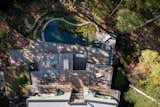16 more photos
Credits
From Gardner Architects LLC
A clearing in a forest conservation reserve. A point of land on the waterfront. The site at Harkers Point is both.
• Harkers Point in Annapolis Maryland comprises several structures on a south and west facing waterfront, organized around a welcome garden court. Their angular geometry yields to organic shapes of the forested shore with a pool forming the compound’s southern boundary. Topping out just under the 45’ height limit, the three-story house connects forest floor to treetops.
• The design grew from the development of the overall site - from 750’ of reconstructed “living shoreline” to a series of exterior spaces linked by pathways through forest conservation areas. The client’s design brief for this 8500sf second home: create sequences of interconnected space that weave together landscape and structures.
• The house is organized into three volumes (west volume, east volume, pavilion) that splay open towards the southern waterfront, expanding access to light and view, allowing interstitial exterior spaces to penetrate the house, and terminating in decks overhanging a pool on the south.
• Every habitable space in the house ties to the landscape - whether a deck, a Juliette balcony, or a cantilevered treehouse platform. “Long views” connect the north and south expanses, and “cross-views” bridge east and west through more focused, framed views.
• A biopool forms the southern edge of the house precinct – an ecosystem using aquatic plants, aggregates, and constantly moving water to maintain its clarity, purity, and pH balance.
• Landscape elements and water link each space to the next. Green roofs on the pavilion and the entry courtyard walkway form part of the site stormwater management strategies. An 8’ diameter fountain - the “source” of water - announces the entry courtyard. Visually and via sound, it connects to the biopool and waterfall to the south. In the pavilion, a hot tub also thematically binds to the biopool and waterfall just outside. This sequence of water elements, from fountain to hot tub to biopool to the views of Whitehall Bay, fuse north to south, land to water.
• Biobased, heat-treated exterior siding extends both vertically and horizontally, an abstraction of trunks and branches. Interior hardwood flooring and tile represent wood, soil, and stone. Vertical expanses of millwork stretching the height of the main stair from first floor to third echo the dense forest of oaks, maples, American Beech, sweetgum, and Black Tupelo. Walls of stained or fumed oak millwork connect the forest center at the north to the bio-pool on the south, and tile recreates the sense of stone along the property’s waterways.
• The design achieves a HERS rating 39 – 61% more efficient than the RESNET Reference Home, beating the Energy Star for Homes target of <61 through a vapor-managed high-performing envelope clad in thermo-treated wood, high-efficiency windows and doors, balanced ventilation with an ERV, ground source heat pumps, motorized shading, and energy-star appliances. Pre-wired for a 38kW solar photovoltaic system, a second phase adding the solar PV system will reduce the HERS rating to 33.



















